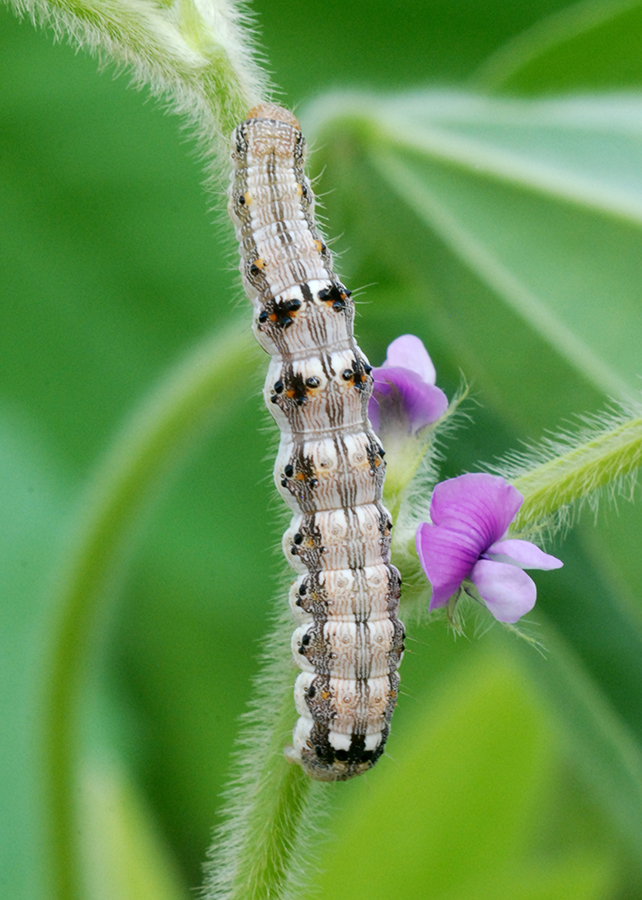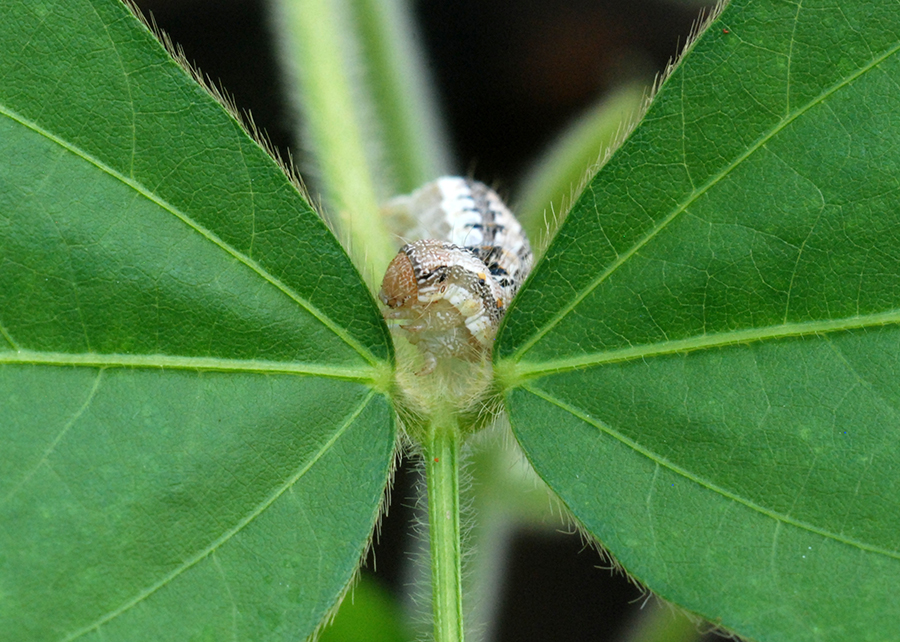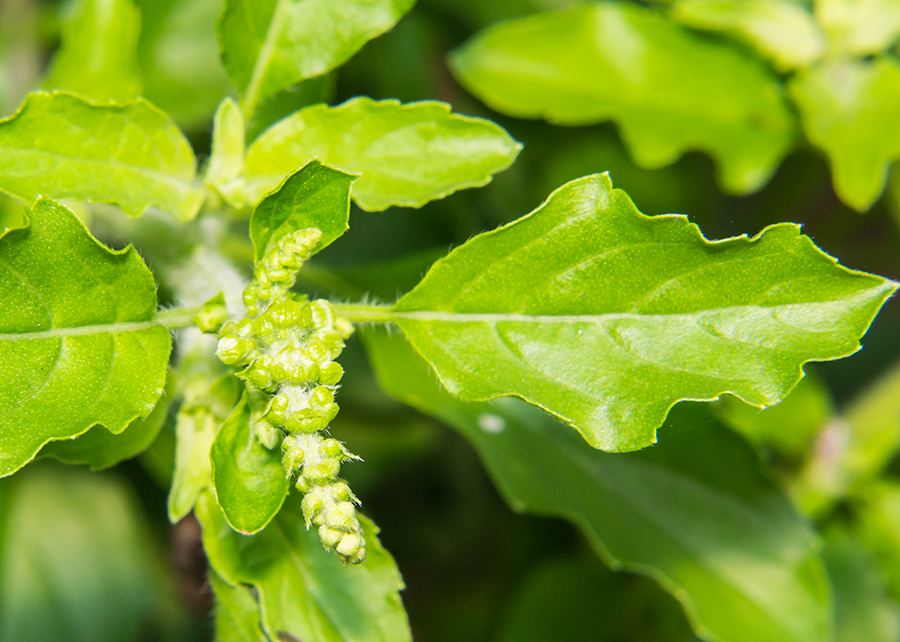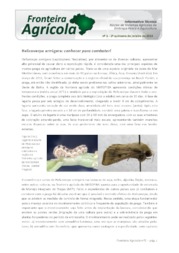Great basil essential oil can control farm pests. Once applied on bean leaves in Embrapa's experiments, it was capable of eliminating Helicoverpa armigera and Anticarsia gemmatalis, two caterpillars that harm several crops. They tested the oils of nine plants and basil's proved to be the most effective. The study is promising for strategies to reduce the use of chemicals in the field . It also expands the range of pest management possibilities in organic agriculture. Traditional great basil (Ocimum basilicum L.), also known as basil or sweet basil, can become the basis for a natural product to control important crop pests. By applying the plant's essential oil on bean leaves, scientists from Embrapa Environment recorded the death of about half of the caterpillars of the Helicoverpa armigera species and a lethality rate of 30% for Anticarsia gemmatalis. The first one was introduced in Brazil in 2013 and it is known for its great voracity, while A. gemmatalis is called soybean caterpillar in the country as it is the legume's main pest (but it is also known as velvetbean caterpillar abroad). Both attack several crops and are thus considered important agricultural pests. Basil was the most efficient among the nine plants whose essential oils were tested to control the two caterpillars in the study (see box). One of the motivations for the use of oils is its low or zero toxicity for the environment and the crops. The scientists performed biological and behavioral assessments of the insects and identified the main compounds present in the oils. Part of the results were published in a research bulletin. The researchers consider this study to be promising, as it completes other scientific investigations conducted with other essential oils, such as Neen oil (Azadiracta indica), often used in pest control. Another important factor is the possibility to reduce the use of agrochemicals, either through substitution or the use of integrated pest management (IPM). The reduction in the use of chemical insectides also helps to reduce insect resistance to such pesticides, a problem that has been growing in the farms. “These oils can also become another tool to control insects in organic agriculture, in which these compounds are allowed, expanding the range of possibilities to manage the pests”, says the Embrapa researcher Jeanne Marinho Prado. A voracious caterpillar With high capacity to spread and a highly polyphagous larval stage (when it can feed from more than 60 plant families), Helicoverpa armigera can be found today in the entire domestic territory, especially attacking maize, bean, cotton and soybean crops. Prado explains that the use of insecticides can promote the resistance of pest insect populations. The lack of new insecticidal molecules and the repeated use of products with similar action in the same crop season can favor the resistance of insect populations, reducing the effectiveness of the applications. Moreover, among consumers and farmers there is an increasing concern with the health of workers and with food and environmental contamination, which in a general sense causes demand for more natural means to offer plants protection against insect attacks. The researcher reports that basil and thyme essential oils were the ones that presented higher bioactivity on A. gemmatalis pupae and caterpillars in biological and behavioral terms. In the adult stage, A. gemmatalis was more affected by sweet orange, teatree and oregano essential oils, followed by citronella and ginger essential oils, the latter of which were responsible for making all deposited eggs unviable. Thyme and mint essential oils were not assessed in the reproductive stage. In the trials with H. armigera caterpillars, the treatments with basil, cinnamon and teatree essential oils stood out, but no treatment changed the caterpillars' leaf consumption. 50% lethality In the trials with H. armigera caterpillars, the treatments with basil, cinnamon and teatree essential oils stood out as they caused the death of half of the caterpillars assessed in ten days. However, none of the oils stopped the caterpillars from feeding. Among the treatments applied against A. gemmatalis, the basil and thyme essential oils caused the highest mortalities observed in caterpillars and pupae. The others caused mortalities below 14%, out of which teatree and ginger oils performed like the control treatment, with no cases of mortality in the insects under assessment. Except for the cinnamon, ginger and sweet orange essential oils, all the others caused a decrease in A. gemmatalis larval weight gain in comparison with the control caterpillars, while the best results were obtained with basil, oregano and thyme. The thyme essential oil was the only one to reduce pupae's weight. The oils tested Essential oils are complex mixes of generally odoriferous volatile lipophilic liquid substances, and volatility is their main characteristic. They are natural substances that originate from medicinal, aromatic and condimental plants, and that are often easily obtained at a low cost and without residual toxicity. They can be a good option for pest control since most are systemic, easily degradable and little or non-phytotoxic. The experiment included the oils of sweet orange (Citrus aurantium dulce), ginger (Zingiber officinale Roscoe), teatree (Melaleuca alternifolia), cinnamon (Cinnamommum cassia), citronella (Cymbopogon sp.), mint (Mentha arvensis), oregano (Origanum vulgare), thyme (Thymus vulgaris) and basil (Ocimum basilicum L.). Out of the essential oils tested during the insects' reproductive stage, sweet orange, teatree and oregano caused a decrease in the number of eggs per female. The same three essential oils caused a reduction in egg viability, followed by citronella and ginger essential oils, the latter of which were responsible for making all deposited eggs unviable. The lifespan of the caterpillars that reached adulthood was not influenced by any of the treatments applied to the A. gemmatalis caterpillars. Thyme essential oil caused mortality in the A. gemmatalis population assessed and a reduction in their caterpillar and pupa weights. The ginger and citronella essential oils caused the inviabilization of all the eggs deposited by A. gemmatalis adults, possibly due to the action of their majority compounds. The scientists are now assessing the lethality of each of the essential oils used in the research in order to define in which they should keep investing in their search for insecticidal molecules aimed at formulating phytosanitary products that can contribute to integrated pest management. Besides Jeanne Marinho Prado, the researchers Lilia de Morais, from Embrapa Agrobiology, and Ricardo Pazianotto, from Embrapa Environment. The power of plants Plants are a large source of often unknown molecules, which can work as a model for chemical synthesis, generating low cost, efficient and environmentally safe products that can be standardized, registered, have quality control aiming at the reproducibility and constancy of chemical components, and especially meet farmers' needs. Plant-derived compounds are potential sources of protection against pests, as they can offer toxic (harming insect development, which could lead to their death), repelling (which pushes insects away) or deterring action (which harms insect feeding or reproduction). Photo: iStock Translation: Mariana Medeiros
-
Great basil essential oil can control farm pests. -
Once applied on bean leaves in Embrapa's experiments, it was capable of eliminating Helicoverpa armigera and Anticarsia gemmatalis, two caterpillars that harm several crops. -
They tested the oils of nine plants and basil's proved to be the most effective. -
The study is promising for strategies to reduce the use of chemicals in the field . -
It also expands the range of pest management possibilities in organic agriculture. |
Traditional great basil (Ocimum basilicum L.), also known as basil or sweet basil, can become the basis for a natural product to control important crop pests. By applying the plant's essential oil on bean leaves, scientists from Embrapa Environment recorded the death of about half of the caterpillars of the Helicoverpa armigera species and a lethality rate of 30% for Anticarsia gemmatalis. The first one was introduced in Brazil in 2013 and it is known for its great voracity, while A. gemmatalis is called soybean caterpillar in the country as it is the legume's main pest (but it is also known as velvetbean caterpillar abroad). Both attack several crops and are thus considered important agricultural pests.
Basil was the most efficient among the nine plants whose essential oils were tested to control the two caterpillars in the study (see box). One of the motivations for the use of oils is its low or zero toxicity for the environment and the crops. The scientists performed biological and behavioral assessments of the insects and identified the main compounds present in the oils. Part of the results were published in a research bulletin.
The researchers consider this study to be promising, as it completes other scientific investigations conducted with other essential oils, such as Neen oil (Azadiracta indica), often used in pest control. Another important factor is the possibility to reduce the use of agrochemicals, either through substitution or the use of integrated pest management (IPM). The reduction in the use of chemical insectides also helps to reduce insect resistance to such pesticides, a problem that has been growing in the farms. “These oils can also become another tool to control insects in organic agriculture, in which these compounds are allowed, expanding the range of possibilities to manage the pests”, says the Embrapa researcher Jeanne Marinho Prado.
 A voracious caterpillar A voracious caterpillar
With high capacity to spread and a highly polyphagous larval stage (when it can feed from more than 60 plant families), Helicoverpa armigera can be found today in the entire domestic territory, especially attacking maize, bean, cotton and soybean crops. |
Prado explains that the use of insecticides can promote the resistance of pest insect populations. The lack of new insecticidal molecules and the repeated use of products with similar action in the same crop season can favor the resistance of insect populations, reducing the effectiveness of the applications.
Moreover, among consumers and farmers there is an increasing concern with the health of workers and with food and environmental contamination, which in a general sense causes demand for more natural means to offer plants protection against insect attacks.
The researcher reports that basil and thyme essential oils were the ones that presented higher bioactivity on A. gemmatalis pupae and caterpillars in biological and behavioral terms. In the adult stage, A. gemmatalis was more affected by sweet orange, teatree and oregano essential oils, followed by citronella and ginger essential oils, the latter of which were responsible for making all deposited eggs unviable. Thyme and mint essential oils were not assessed in the reproductive stage. In the trials with H. armigera caterpillars, the treatments with basil, cinnamon and teatree essential oils stood out, but no treatment changed the caterpillars' leaf consumption.
50% lethality

In the trials with H. armigera caterpillars, the treatments with basil, cinnamon and teatree essential oils stood out as they caused the death of half of the caterpillars assessed in ten days. However, none of the oils stopped the caterpillars from feeding.
Among the treatments applied against A. gemmatalis, the basil and thyme essential oils caused the highest mortalities observed in caterpillars and pupae. The others caused mortalities below 14%, out of which teatree and ginger oils performed like the control treatment, with no cases of mortality in the insects under assessment.
Except for the cinnamon, ginger and sweet orange essential oils, all the others caused a decrease in A. gemmatalis larval weight gain in comparison with the control caterpillars, while the best results were obtained with basil, oregano and thyme. The thyme essential oil was the only one to reduce pupae's weight.
The oils tested Essential oils are complex mixes of generally odoriferous volatile lipophilic liquid substances, and volatility is their main characteristic. They are natural substances that originate from medicinal, aromatic and condimental plants, and that are often easily obtained at a low cost and without residual toxicity. They can be a good option for pest control since most are systemic, easily degradable and little or non-phytotoxic. The experiment included the oils of sweet orange (Citrus aurantium dulce), ginger (Zingiber officinale Roscoe), teatree (Melaleuca alternifolia), cinnamon (Cinnamommum cassia), citronella (Cymbopogon sp.), mint (Mentha arvensis), oregano (Origanum vulgare), thyme (Thymus vulgaris) and basil (Ocimum basilicum L.). |
Out of the essential oils tested during the insects' reproductive stage, sweet orange, teatree and oregano caused a decrease in the number of eggs per female. The same three essential oils caused a reduction in egg viability, followed by citronella and ginger essential oils, the latter of which were responsible for making all deposited eggs unviable. The lifespan of the caterpillars that reached adulthood was not influenced by any of the treatments applied to the A. gemmatalis caterpillars.
Thyme essential oil caused mortality in the A. gemmatalis population assessed and a reduction in their caterpillar and pupa weights. The ginger and citronella essential oils caused the inviabilization of all the eggs deposited by A. gemmatalis adults, possibly due to the action of their majority compounds. The scientists are now assessing the lethality of each of the essential oils used in the research in order to define in which they should keep investing in their search for insecticidal molecules aimed at formulating phytosanitary products that can contribute to integrated pest management.
Besides Jeanne Marinho Prado, the researchers Lilia de Morais, from Embrapa Agrobiology, and Ricardo Pazianotto, from Embrapa Environment.

The power of plants
Plants are a large source of often unknown molecules, which can work as a model for chemical synthesis, generating low cost, efficient and environmentally safe products that can be standardized, registered, have quality control aiming at the reproducibility and constancy of chemical components, and especially meet farmers' needs.
Plant-derived compounds are potential sources of protection against pests, as they can offer toxic (harming insect development, which could lead to their death), repelling (which pushes insects away) or deterring action (which harms insect feeding or reproduction).
Photo: iStock
Translation: Mariana Medeiros 


